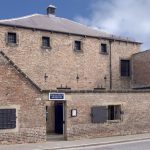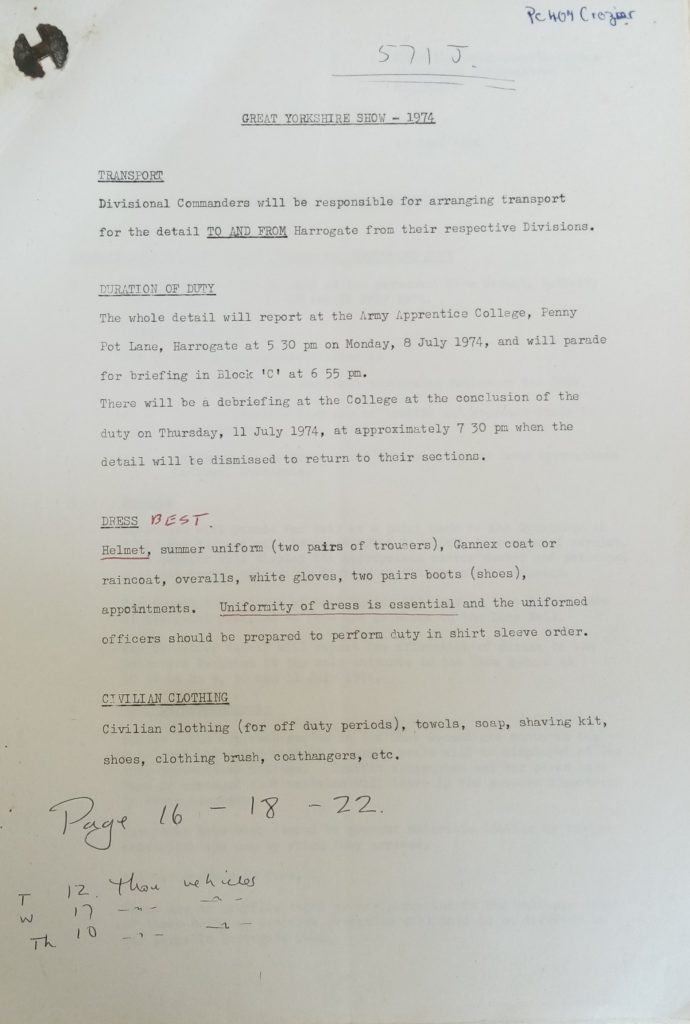The 161st Great Yorkshire Show started today at the Great Yorkshire Showground in Harrogate. The event showcases the best of British farming, food and countryside, as well as first class entertainment.
As one of the biggest agricultural events in the English calendar, and with more than 130,000 visitors and over 8500 animals in attendance, the show requires a strong police presence.
The Great Yorkshire Show team work in partnership with North Yorkshire Police and the National Counter Terrorism Security Office to ensure the safety and security of the public. This partnership with North Yorkshire Police has been developed over many years, as demonstrated by a document in the collections of Ripon Museums, dating from 1974.
The document contains instructions for the police working at the Great Yorkshire Show on 9, 10 and 11 July 1974, under specific headings, including transport, dress, lost children and accommodation. The document also details all the police officers working at the event and the duties they were assigned.
Chief Superintendent Glendinning was the officer in charge of the event, with Superintendent Dobbs as second in command. There were four officers in charge of Road Traffic, Traffic Control and the Showground and a further 80 officers assigned to various roles. The document belonged to PC 407 Crozier, who was assigned to traffic control on the junction of Wetherby Road and Railway Road from 8am until 8pm.
Highlights from the instructions provided include:
“DRESS Helmet, summer uniform (two pairs of trousers), Gannex coat or raincoat, overalls, white gloves, two pairs boots (shoes), appointments. Uniformity of dress is essential and the uniformed officers should be prepared to perform duty in shirt sleeve order”
“CIVILIAN CLOTHING Civilian clothing (for off duty periods), towels, soap, shaving kit, shoes, clothing brush, coathangers, etc”
“PARADES Personnel will parade for duty at a point near to the Gymnasium at 8am each day and will be transported to points by personnel carrier…personnel will not travel on another carrier as this creates confusion”
“TRAFFIC ARRANGEMENTS Traffic approaches and car parks have been so arranged that vehicles will leave in the reverse direction to their approach. Car parks have been fenced to prevent motorists leaving by routes other than the one by which they arrived.
There are no overflow coach or car parks and in the unlikely event of there being an overflow, vehicles will have to be directed to car parks in Harrogate Town.”
“PERSONAL RADIOS personal radios are to be issued to all personnel. Each Officer must ensure that the batteries are handed to his Sector Sergeant after the conclusion of his day’s duty, for re-charging. Sergeant Dodd, the Liaison Officer, will organise the ‘charging unit’ for the batteries…
Call Sign will be ‘Yankee’ and the number will be that to which each individual officer is allocated”
“PHOTOGRAPHY Photographs must not be taken on the Show Ground without official permission and no photograph must be sold in the Show Ground; the object here is to prevent the itinerant type of photographer usually found at a seaside resort.
Difficulties have also been xperienced with persons selling balloons etc., and they should be escorted from the Show Ground by an official with, if necessary, Police assistance”
“EXHIBITORS AND COMMERCIAL VEHICLES Live pigeons in cars and vans will arrive between 7 30pm and 9 30pm and they are to be directed to Gate ‘G’…
Horse boxes will enter by Gate E2 off the old Railway Road.”
“MESSING AND ACCOMMODATION Toilets, showers, drying room, washing facilities and razor points are self-contained in the same area. A key is provided for each of the rooms and it will be for the occupants to arrange for one person to lock the room when it is vacated. Lockers are provided but each Officer is advised to bring a padlock for security reasons…
All Police personnel are invited to use the Sergeant’s Mess for recreational purposes. It is emphasised that when attending the Sergeant’s Mess, collars and ties should be worn.”
This document is part of an extensive document archive held by Ripon Museum Trust, which records the history of the police service in Yorkshire and the Humber over the past 200 years.
 Prison & Police Museum
Prison & Police Museum